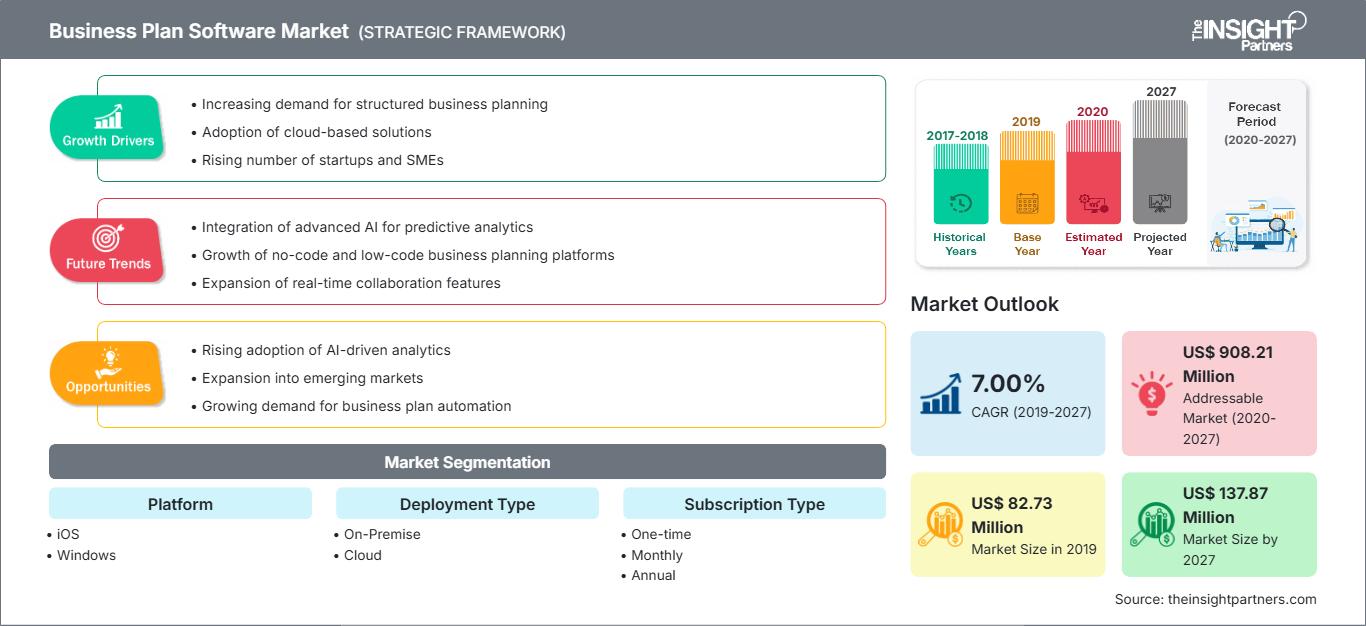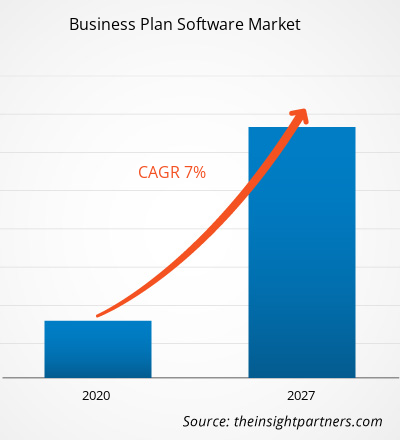El mercado de software de planes de negocios se valoró en US$ 82.730,3 mil en 2019 y se proyecta que alcance los US$ 13.7871,4 mil para 2027. Se espera que el mercado de software de planes de negocios crezca a una CAGR del 7,00% durante el período de pronóstico de 2020 a 2027.
El mercado de software para planes de negocios está ganando importancia a nivel mundial con el paso de los años. Tanto los países desarrollados como los países en desarrollo están experimentando un crecimiento significativo en el número de startups emergentes con emprendedores expertos en tecnología. La demanda de software para planes de negocios es máxima entre los nuevos emprendedores en los países desarrollados; sin embargo, los emprendedores emergentes están tomando conciencia de los beneficios de los programas informáticos para planes de negocios. Esto está impulsando el crecimiento de este mercado. El software para planes de negocios disponible en el mercado también es utilizado por diversas consultoras que ofrecen servicios de planificación empresarial. Estas consultoras reciben anualmente una gran cantidad de emprendedores que buscan planes de negocios sólidos en diferentes industrias. Ante el aumento de la demanda de planes de negocios provenientes de diversos sectores, las consultoras optan por planes informáticos que les proporcionan una amplia gama de ejemplos de planes de negocios. Esto les ayuda a captar una amplia base de clientes y a pagar la suscripción. Este factor impulsa el crecimiento del mercado de software para planes de negocios.
Si bien existen diversos puntos de vista sobre los daños que puede causar la COVID-19, lo cierto es que se está propagando por todo el mundo. Los nuevos casos están aumentando en lugares como Estados Unidos, Canadá, Europa, África, Oriente Medio, India, Australia, Corea del Sur y Japón, entre otros países. Si bien el impacto en diversas empresas es bien conocido, el sector tecnológico también se enfrenta a la mayor disrupción de los últimos tiempos.
El mercado global de software para planes de negocios se segmenta según parámetros como plataforma, tipo de implementación, tipo de suscripción y geografía. Según la plataforma, el mercado se ha categorizado en iOS, Windows y otros. El segmento de implementación se ha dividido en local y en la nube. El segmento de suscripción se clasifica en única, mensual y anual. Geográficamente, el software para planes de negocios se segmenta en Norteamérica, Europa, Asia Pacífico (APAC), Oriente Medio y África (MEA) y Sudamérica (SAM).
Personalice este informe según sus necesidades
Obtendrá personalización en cualquier informe, sin cargo, incluidas partes de este informe o análisis a nivel de país, paquete de datos de Excel, así como también grandes ofertas y descuentos para empresas emergentes y universidades.
Mercado de software de planes de negocios: Perspectivas estratégicas

-
Obtenga las principales tendencias clave del mercado de este informe.Esta muestra GRATUITA incluirá análisis de datos, desde tendencias del mercado hasta estimaciones y pronósticos.
Perspectivas del mercado de software de planes de negocios
Acentuación del número de empresas emergentes
El impresionante crecimiento de la industrialización global se debe al creciente número de startups, pequeñas y medianas empresas (PYME) y grandes organizaciones en todos los sectores. El ecosistema de startups está en auge en el panorama actual a nivel mundial e impulsa la economía de todos los países. Los nuevos emprendedores buscan servicios de planificación empresarial para evaluar sus perspectivas de negocio. Considerando que la mayoría de los emprendedores emergentes en los países desarrollados conocen bien los beneficios de la planificación empresarial basada en software, la demanda de software de planificación empresarial entre las empresas que ofrecen servicios de planificación empresarial está en auge. Este parámetro influye positivamente en el crecimiento del mercado de software de planificación empresarial.
Información del mercado basada en plataformas
Las empresas desarrolladoras de software de planificación empresarial se centran considerablemente en el desarrollo de sus productos para diversas plataformas. Existe una amplia disponibilidad de software para iOS, Windows, Linux y la web, lo que facilita a los nuevos emprendedores o propietarios de negocios la definición y evaluación de su respectiva hoja de ruta empresarial. El segmento de otros (web y Linux) domina el mercado de software de planificación empresarial, seguido por el de Windows y el de iOS.
Información del mercado basada en el tipo de implementación
El software de planificación de negocios en la nube, así como el software local, está ganando popularidad entre nuevos emprendedores y consultoras que ofrecen servicios de planificación empresarial. El segmento de la nube genera la mayor parte de la demanda, ya que es comparativamente más económico y se debe a la sólida infraestructura de red en los países desarrollados. Además, las empresas desarrolladoras de software de planificación de negocios se están centrando en el diseño de parches de seguridad de alto nivel para eliminar el riesgo de ciberataques. Este factor también está generando una demanda significativa por parte de los usuarios finales, impulsando así el mercado de software de planificación de negocios.
Información del mercado basada en el tipo de suscripción
El ecosistema global de startups está en auge, y cada nuevo empresario busca un plan de negocios adecuado. Esto ha impulsado un aumento en el número de desarrolladores de software de planes de negocios en todo el mundo. Estos desarrolladores lanzan sus productos mediante suscripción, como una suscripción única, una suscripción mensual y una suscripción anual. La demanda de cada uno de los tipos de suscripción mencionados aumenta constantemente entre los diferentes usuarios finales. El segmento de suscripción anual domina el mercado de software de planes de negocios, seguido del segmento de suscripción única y el segmento mensual.
Los actores del mercado de software para planes de negocios se centran en estrategias como iniciativas de mercado, adquisiciones y lanzamientos de productos para mantener su posición en el mercado. Algunos desarrollos de los actores clave del mercado son:
En febrero de 2019, Upmetrics Business Planner llegó para ayudarte. Esta plataforma optimizada e integral permite a los clientes crear planes de negocio personalizados, elaborar proyecciones financieras y mucho más. Ahora mismo, puedes obtener una suscripción de por vida de forma rápida y sencilla con un descuento de más del 95 % por solo $24.99.
Perspectivas regionales del mercado de software de planes de negocios
Los analistas de The Insight Partners han explicado detalladamente las tendencias regionales y los factores que influyen en el mercado de software para planes de negocios durante el período de pronóstico. Esta sección también analiza los segmentos y la geografía del mercado de software para planes de negocios en América del Norte, Europa, Asia Pacífico, Oriente Medio y África, y América del Sur y Central.
Alcance del informe de mercado de software de planes de negocios
| Atributo del informe | Detalles |
|---|---|
| Tamaño del mercado en 2019 | US$ 82,73 millones |
| Tamaño del mercado en 2027 | US$ 137,87 millones |
| CAGR global (2019-2027) | 7.00% |
| Datos históricos | 2017-2018 |
| Período de pronóstico | 2020-2027 |
| Segmentos cubiertos |
Por plataforma
|
| Regiones y países cubiertos |
América del norte
|
| Líderes del mercado y perfiles de empresas clave |
|
Densidad de actores del mercado de software de planes de negocios: comprensión de su impacto en la dinámica empresarial
El mercado de software para planes de negocios está creciendo rápidamente, impulsado por la creciente demanda de los usuarios finales debido a factores como la evolución de las preferencias de los consumidores, los avances tecnológicos y una mayor comprensión de los beneficios del producto. A medida que aumenta la demanda, las empresas amplían su oferta, innovan para satisfacer las necesidades de los consumidores y aprovechan las tendencias emergentes, lo que impulsa aún más el crecimiento del mercado.

- Obtenga una descripción general de los principales actores clave del mercado de software de planes de negocios
Mercado de software de planes de negocios: por implementación
- En las instalaciones
- Nube
Mercado de software de planes de negocios por plataforma
- Ventanas
- iOS
- Otros
Mercado de software de planes de negocios: por tipo de suscripción
- Una sola vez
- Mensual
- Anual
Mercado de software de planes de negocios por geografía
-
América del norte
- A NOSOTROS
- Canadá
- México
-
Europa
- Francia
- Alemania
- Rusia
- Reino Unido
- Italia
- Resto de Europa
-
Asia Pacífico (APAC)
- Porcelana
- India
- Japón
- Australia
- Resto de APAC
-
MEA
- Arabia Saudita
- Emiratos Árabes Unidos
- Sudáfrica
- Resto de MEA
-
SAM
- Brasil
- Argentina
- Resto de SAM
Mercado de software de planes de negocios: perfiles de empresas
- Soluciones empresariales Atlas, Inc.
- enloop, Inc.
- Palo Alto Software, Inc.
- PlanGuru, LLC
- Planificación sencilla
- Startups.com LLC
- StratPad Inc.
- Tarkenton.com
- La tienda de planes de negocios ltda.
- UpMetrics
- Análisis histórico (2 años), año base, pronóstico (7 años) con CAGR
- Análisis PEST y FODA
- Tamaño del mercado, valor/volumen: global, regional y nacional
- Industria y panorama competitivo
- Conjunto de datos de Excel
Informes recientes
Informes relacionados
Testimonios
Razón para comprar
- Toma de decisiones informada
- Comprensión de la dinámica del mercado
- Análisis competitivo
- Información sobre clientes
- Pronósticos del mercado
- Mitigación de riesgos
- Planificación estratégica
- Justificación de la inversión
- Identificación de mercados emergentes
- Mejora de las estrategias de marketing
- Impulso de la eficiencia operativa
- Alineación con las tendencias regulatorias






















 Obtenga una muestra gratuita para - Mercado de software de planes de negocios
Obtenga una muestra gratuita para - Mercado de software de planes de negocios